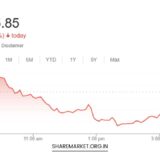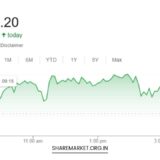What is Trading in Share Market

What is Trading in Share Market
What is Trading?
Trading, in the context of financial markets, refers to the buying and selling of various financial instruments, such as stocks, bonds, commodities, currencies, and derivatives.
It involves the exchange of these instruments between buyers and sellers, typically facilitated through organized platforms known as exchanges.
In the case of stock trading, investors and traders engage in the buying and selling of shares or stocks issued by publicly listed companies.
These transactions occur in the stock market, which serves as a marketplace where buyers and sellers meet to execute their trades.
Traditionally, stock trading took place on physical trading floors, with traders physically present to carry out transactions.
However, with advancements in technology, the emergence of electronic trading platforms has revolutionized the trading landscape.
Online trading and investing platforms now provide individuals with the ability to participate in stock trading from the convenience of their own homes or offices, using computers or mobile devices.
The accessibility of online trading platforms has democratized stock market participation, allowing a larger section of the population to engage in trading and investing.
It has opened up opportunities for individuals to actively manage their portfolios, make investment decisions, and potentially benefit from the financial markets’ fluctuations.
Trading in financial markets serves several purposes. It provides liquidity to the market, allowing investors to buy and sell securities when needed.
It facilitates price discovery, as the continuous buying and selling of securities helps determine their market value.
Trading also enables investors to diversify their portfolios, manage risks, and potentially earn profits by taking advantage of market movements.
However, it’s important to note that trading in financial markets carries risks. Market volatility, economic factors, geopolitical events, and other variables can influence the prices of securities, leading to potential gains or losses for traders.
Therefore, it is essential for traders and investors to conduct thorough research, stay informed about market trends, and employ appropriate risk management strategies when engaging in trading activities.
Overall, trading in financial markets, including stock trading, plays a crucial role in the global economy, providing opportunities for investors to allocate capital, participate in wealth creation, and contribute to the efficient functioning of the financial system.
What is Share Trading?
Share trading, also known as stock trading or equity trading, refers to the buying and selling of shares or stocks of publicly traded companies listed on stock exchanges.
It is a popular form of investment and trading activity that allows individuals and institutional investors to participate in the ownership and potential profits of companies.
When engaging in share trading, investors aim to profit from the price fluctuations of the shares they buy and sell.
The goal is to buy shares at a lower price and sell them at a higher price, thereby generating a profit. Conversely, if the share price decreases after purchase, investors may incur a loss if they sell the shares at a lower price.
With the advent of technology, online share trading has gained popularity. Online share trading platforms provide individuals with the convenience of buying and selling shares through a digital interface.
These platforms are often provided by brokerage firms or financial institutions and allow investors to place trade orders, track their portfolio, access research and analysis tools, and monitor market data in real-time.
One of the key advantages of online share trading is the direct access it provides to the stock market without the need for intermediaries such as brokers or agents.
Investors can open an online share trading account, deposit funds, and execute trades on their own, giving them greater control over their investment decisions.
Online share trading platforms also offer a wide range of investment options beyond individual company shares.
Investors can trade in mutual funds, exchange-traded funds (ETFs), bonds, options, and other securities through these platforms, enabling them to diversify their portfolios and explore different investment opportunities.
Additionally, online share trading platforms often provide research resources, educational materials, and analytical tools to help investors make informed investment decisions.
They may offer market analysis, company financials, news updates, and technical indicators to assist investors in assessing potential investment opportunities.
However, it’s important to note that share trading carries risks, including market volatility, economic factors, and company-specific risks.
It requires careful analysis, risk management strategies, and staying informed about market trends and news that can impact share prices.
Overall, share trading provides individuals with the opportunity to participate in the financial markets, potentially generate profits, and build wealth over the long term.
It allows investors to take an active role in managing their investments and capitalize on market opportunities through the convenience and accessibility of online trading platforms.
Difference Between Trading and Investing
The difference between trading and investing lies primarily in the time horizon and approach taken by individuals in the stock market:
1. Time Horizon
Trading involves short-term transactions where positions are typically held for a brief period, ranging from seconds to days.
Traders aim to take advantage of short-term price fluctuations and market volatility. On the other hand, investing involves a longer-term perspective, where positions are held for months, years, or even decades.
Investors focus on the long-term growth potential of a company and its ability to generate returns over time.
2. Approach
Traders rely on technical analysis, market trends, and short-term price movements to make buying and selling decisions.
They often use tools like charts, indicators, and trading strategies to identify short-term trading opportunities. In contrast, investors focus more on fundamental analysis, examining the company’s financial health, competitive advantage, industry trends, and long-term growth prospects.
They aim to build a diversified portfolio of quality stocks that can generate returns over the long run.
3. Frequency of Transactions
Traders engage in frequent buying and selling of shares, aiming to capitalize on small price movements and generate quick profits.
They may execute multiple trades within a single day (day trading) or hold positions for a few days (swing trading).
Investors, on the other hand, have a lower frequency of transactions. They typically buy shares with a long-term view and hold onto them for a considerable period, allowing the investment to grow and potentially benefit from dividends and capital appreciation.
4. Risk and Returns
Trading is often associated with higher risks due to the short-term nature of transactions and the reliance on market timing.
Traders need to closely monitor market conditions, manage risk, and use stop-loss orders to limit potential losses.
They may experience both significant gains and losses within a short period. Investing, on the other hand, carries its own risks but is generally considered less volatile than trading.
Investors aim to benefit from long-term market trends and the overall growth of the economy. They may tolerate short-term fluctuations and focus on the potential for compounding returns over time.
It’s important to note that trading and investing are not mutually exclusive, and many individuals engage in both activities based on their goals and risk tolerance.
Some investors may incorporate short-term trading strategies as part of their overall investment approach.
Understanding the differences between trading and investing can help individuals align their strategies with their financial goals and time horizons.
How to Start Trading?
To start trading in the stock market, follow these steps:
1. Research and Educate Yourself
Before you begin trading, it’s important to educate yourself about the stock market, various trading strategies, and risk management techniques.
Learn about fundamental analysis, technical analysis, market trends, and other factors that can impact stock prices. You can find numerous online resources, books, and courses that provide valuable information on trading.
2. Choose a Stockbroker
Select a reliable stockbroker who is registered with SEBI (Securities and Exchange Board of India) and a recognized stock exchange.
Consider factors such as brokerage charges, customer service, trading platforms, research tools, and the ease of account opening process.
3. Open a Demat and Trading Account
Contact the chosen stockbroker to open a demat and trading account. You will need to provide necessary documents such as your PAN Card, proof of address (e.g., Aadhaar card, passport, utility bill), proof of identity (e.g., PAN card, Aadhaar card, passport), and bank account details.
Fill out the account opening forms and submit the required documents along with any fees or charges as specified by the stockbroker.
4. Complete the KYC Process
As part of the account opening process, you will need to complete the Know Your Customer (KYC) formalities.
This involves providing your personal details, financial information, and submitting the required documents for verification.
The stockbroker will guide you through the KYC process, which may include in-person verification or online verification using Aadhaar-based eKYC.
5. Fund Your Trading Account
Once your demat and trading account is activated, you will need to transfer funds to your trading account. This can be done through online banking or by depositing a cheque in favor of your trading account.
The funds in your trading account will be used for buying and selling shares.
6. Choose a Trading Platform
Most stockbrokers offer online trading platforms that allow you to place buy and sell orders from the convenience of your home or office.
These platforms provide real-time market data, charts, research reports, and other tools to assist you in making trading decisions. Familiarize yourself with the trading platform and explore its features before you start trading.
7. Develop a Trading Plan
Before executing any trades, it’s important to have a trading plan in place. Define your investment goals, risk tolerance, and preferred trading strategies.
Determine the types of stocks or securities you want to trade, the timeframes you will focus on (intraday, short-term, or long-term), and the risk management techniques you will employ.
A well-defined trading plan can help you stay disciplined and make informed trading decisions.
8. Start Trading
Once you are ready, you can start trading by placing buy and sell orders through your trading account. Monitor the market, analyze stock prices, and execute trades based on your trading plan.
It’s important to keep track of your trades, review your performance regularly, and make adjustments to your trading strategies as needed.
Remember, trading in the stock market involves risks, and it’s advisable to start with a small amount of capital and gradually increase your exposure as you gain experience and confidence.
Continuous learning, adapting to market conditions, and staying updated with market news and trends will help you enhance your trading skills over time.

















